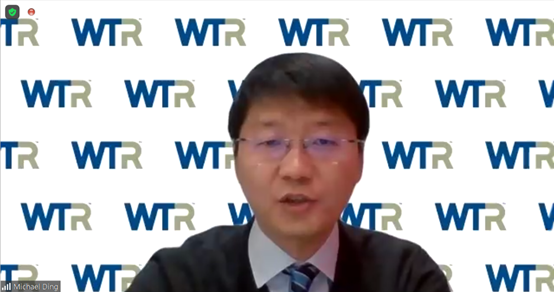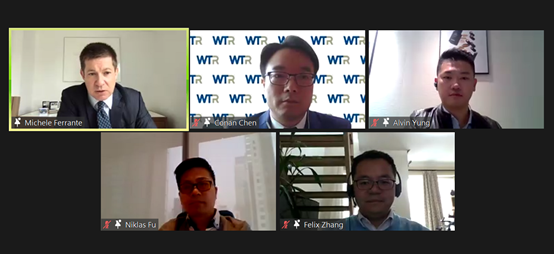On December 10, the two-day China Brand Strategy 2020 was held as scheduled. This year marks the fifth year of cooperation between the China Association of Foreign Enterprises with Foreign Investment Quality Brands Protection Committee ("QBPC") and the Forum's sponsor, World Trademark Review ("WTR").
Michael Ding, Chairman of QBPC and ABB's Head of Intellectual Property Affairs for Asia, Middle East and Africa, delivered a keynote speech. Ding first briefed on QBPC's role, responsibilities and thanked WTR for its invitation. Michael said that brand protection shall consider “3C”, namely communication, cooperation and commercialization. He mentioned the need to focus on communication with colleagues, peers in the industry and the government authorities, learning from experience and understanding the functions of government agencies in order to seek quick solutions; Collaboration and communication shall complement each other, and attention shall be paid to collaboration with professional institutions such as WTR or QBPC, various e-commercial platforms and government authorities to learn professional knowledge and improve their abilities so as to create a better business IP environment for brand owners; Commercialization means better understanding the business models and value chains, managing investment and return and designating more strategic and cost-effective mechanisms and processes for brand protection, which are important elements of brand protection.

There were two topics on Day One of the forum.
First topic is Online Shopping: your brand’s latest battleground. With the growing importance of e-commerce, e-commerce has become a major market for many brands through either official channels or third-party platforms. As they explore the expanding world of new technologies, brand protection professionals must also be aware of existing and potential risks. Michele Ferrante, who is Founder and Managing Partner at Ferrante Intellectual Property presided over this topic. Conan Chen from Amazon Kindle Business, Niklas Fu from Richemont, Alvin Yung from Chanel and Felix Zhang from Novartis delivered their speeches. The speakers had a lively discussion and shared their experience on cutting-edge multi-platform surveillance and enforcement strategies, problems in live online shopping, and the uncertainties facing brands. Alvin Yung said,the emerging issue of online brand protection has been brought about by the rapid popularization of the Internet, the growing maturity of the modern logistics industry, the continuous improvement of online banking, mobile phone and other payment means, and the continuous expansion of online shopping transaction scale. These new platforms and expansions allow counterfeit sellers to do business with a higher level of security. Platforms and brand owners find it difficult to identify the counterfeiters due to their lack of technology or resources for monitoring. The simple act of taking it down is not enough to curb counterfeiting; brands must seek new ways out. Through the coordination between the brand owners of the online platform and the government authorities, and preemptive measures could be taken against counterfeiters in the supply chain, hence the visibility of fakes on the Internet can be reduced, the source of fakes can be found in the physical location, and the society can be kept away from fakes.

The second topic is the rise of the brand protection mechanism. Michael Ding moderated the session. Since companies require trademark teams to do more work with less budget, many organizations are using a variety of technical tools to relieve some of the pressure on labor. It is not easy to choose the solution that best meets the needs of the enterprise. How to make the most of the budget without reducing the coverage and effect, keep the organization up to date with the future development, and determine the future needs are all the issues to be addressed in brand protection. Michael Yu, North Asia Brand Protection Head at Unilever, Abigail Tan, the Regional Lead Counsel at Zalora and Deborah Hampton, the Senior Trademark & Copyright Program Manager at The Chemours Company put forward many constructive suggestions. On the issue of budget, a lot of consensus have been reached. Different development model needs a different budget. To set up brand protection strategy, improve their professional skills, make value coverage, forecast the result evaluation, establish the sophisticated reporting system and complaints-handling system, learn the latest research results are good methods. Michael concluded that it was important to convince top management of the value of brand protection and support them build a high-level vision and long-term strategy. The brand protection work could go smoothly with the top down support.

On the morning of 11th, the second session of the forum began. Alban Kwan, Regional Director for CSC, delivered the keynote speech. In his speech, Kwan introduced the Internet policies in different countries and jurisdictions. There were also two round tables in this forum.
The first is about Managing Enforcement Matters within China's Borders. China's trademark law and brand protection environment are constantly developing and evolving. Therefore, brand management in China needs to constantly adapt to the new pattern. This session explores how to design and implement flexible and robust law enforcement strategies. Dan Chen, a partner at Fairsky Law Office, moderated this seminar. Thierry Dubois, who is the Chairman of the Selective Trademark Union (“STU”) as well as the Managing Director (Asia Pacific) of the Federation of the Swiss Watch Industry (“FHS”), Min Gao, 3M’s Intellectual Property Head for the Greater China area, Robin Smith, Vice President and General Counsel, China and APAC Legal of Lego and Charlotte Trinh, Australia’s intellectual property Counsellor to China made speeches one after another. The discussion will focus on three questions: when faced with the dilemma of brand protection, the choice is administrative, civil, or criminal? What are the tools that can assist with law enforcement? And when and where to sue and recover damages? The speakers shared their successful experiences in dealing with these issues, and Robin Smith also made a case sharing for civil protection.

The second topic of discussion at the Forum is bad-faith registration. Infringers are constantly looking for innovative ways to make use of brands. Brand owners and malicious rivals are constantly staging "cat and mouse games." It focuses on how government agencies change their approach to malicious applications and sharing some best practices to combat infringements. Partner at Wanhuida Intellectual Property and a Member of the firm’s Management Committee Jason Yao chaired the symposium. Aimin Huo, who is the trademark attorney at CCPIT Patent and Trademark Law Office, Frank Liu, the senior IP manager of Emerson Electric China, Paul Lu, Director of IP, Greater China at Schneider Electric and Alicia Martin Santos, in-house counsel for Tommy Hilfiger attended this seminar. During the discussion, the speakers had an in-depth exchange on the internal and external causes of bad-faith registration and legal measures to deal with them. Alicia noted that many of the infringers were crafty and could bypass many regulatory procedures by registering different parts of a trademark, such as text, graphics, etc. Liu pointed out that, because trademark registration costs were as low as only 300 CNY, some infringers would rush to register a lot of trademarks. On the other side, brand owners would have to pay high legal fees and time to deal with it. Lu added that a civil suit could be filed against a trademark in use, but it was tricky to handle trademarks which have not been used for more than five years because it could no longer be invalidated according to the rule of “no in use for three consecutive years”. To tackle these problems, in Liu's view, the most fundamental thing is to strengthen the punishment on infringers or to let them feel the "pain". The trademark application fee and cost could be increased. Not only individuals but also trademark agencies engaging in bad-faith registration need to be severely cracked down.
The two-day forum covered from theory to practice, from personality to generality, from experience to skills. It brought new knowledge, new ideas and new approaches to brand protection. The participants benefited a lot. It also strengthened their determination to fight against the infringers and protect the brand value!
